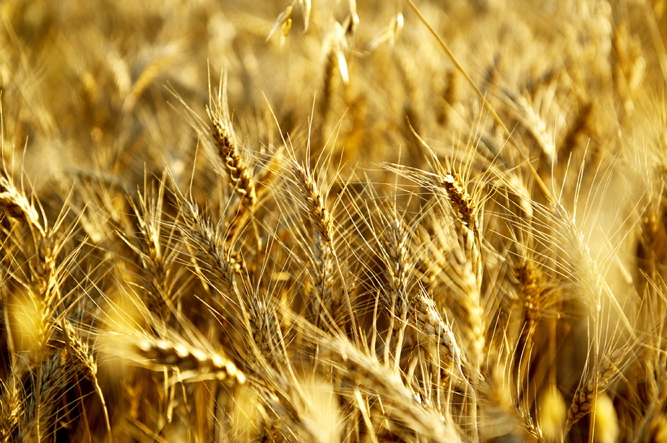Bread is the staff of life. While the most avid gardeners grow all their own vegetables, few harvest even a minimal amount of grain to make bread.
That may be because many people think they’d need huge fields of “amber waves of grain” (cue “America the Beautiful”) to make growing wheat, oats, rye or barley worthwhile. Not so.
“A Maine gardener could grow all the wheat they need for the family on a plot the size of a two- or three-car garage, about 30-by-30 feet,” Richard Roberts, a grain grower from Solon and a member of Maine Grain Alliance, said in a telephone interview. That would be about 60 pounds of grain, enough to fill two 5-gallon pails.
Wheat requires full sun, but it will grow in most soils as long as the ground is not too wet, Roberts said. The soil may need a dose of wood ashes and some added nitrogen.
Since wheat is a grass, before I talked to Roberts, I had thought that you might plant it with a spreader like you’d use to seed a lawn. I was way off the mark.
The secret, Roberts said, is to give each plant a lot of room, planting the seeds in rows that are 6 inches apart with 6 to 8 inches between seeds in each row. With plenty of room, each seed will produce six to 12 shoots.
To start growing wheat this year, you need a spring wheat. Johnny’s Selected Seeds in Winslow offers Glenn, a hard red wheat. Hard Red Fife, developed in Ontario in the 1840s, is available from Fedco, a seed cooperative based in Winslow.
Spring wheat should be planted as soon as the soil can be worked, usually in late April, Roberts said, or earlier in southern Maine.
“I always do it during April school vacation because the kids are around to pick up the rocks,” Roberts said.
Weeds put a lot of pressure on spring wheat, so Roberts suggests an underplanting of white clover, which keeps down weeds and adds nitrogen to the soil.
The advantage to winter wheat, which you plant around the first frost, is that it gets a head start on the weeds. It grows a few inches in the fall, goes dormant in winter, resumes growth in the spring and usually has a higher yield.
Roberts is excited about a heritage winter wheat from Estonia called Sirvinta. The Maine Grain Alliance got some Sirvinta wheat from Will Bonsall, a seed-saving guru in Industry. Test growers, including Roberts, planted 14 pounds of it on 11 acres in the fall of 2015 and harvested 1,500 pounds of it last season. If the growers harvest enough this coming summer to cover potential orders, Fedco could begin offering it for sale this coming fall.
Wheat fields require crop rotation if you garden organically. When you aren’t growing wheat, crops like peas or beans add nitrogen to the soil, and after they are harvested, they can be tilled into the soil to add organic matter.
Harvesting and processing wheat from a home plot isn’t difficult, Roberts said, though it does require a number of steps. It can be cut with a hand sickle, after which the stalks are tied together and left to dry under cover for a couple of weeks. The grain is ready for threshing when if you bite down on them, the individuals grains are about as hard as nuts.
Small threshers are available for home use, but you also can thresh by hand by cutting the grain heads, putting them in a large paper bag and shaking or pounding it. Another method is to put the stalks on a tarp and beat them with a dowel.
Next comes winnowing. The simplest method is to set up a fan and drop the threshed wheat in front of the breeze into a bowl. The light chaff will blow away. Store the grain until you want flour, grinding only what you need for the recipe you’re cooking.
Roberts was quick to remind people that the straw left over from this process also has value. It sells for $10 a bale, or you can use it to mulch garlic or other crops.
Maine gardeners can grow grains other than wheat, including rice, oats and heritage predecessors of wheat. If you opt to grow oats, be sure to get a variety without hulls.
Rice can be grown in Maine, and it doesn’t need to grow in water either, Roberts said, as flooding the field is really just a way of controlling weeds. While Fedco has introduced Akamuro rice, which the catalog calls ideal for Maine, he knows Maine residents who have successfully grown eight to 10 varieties of rice.
For people who are intolerant of gluten, Roberts recommends emmer and einkorn, two ancient grains that are wheat predecessors. While people with celiac disease can’t eat them, people with lesser stages of gluten intolerance often can.
So if you have a little extra land for gardening and want to become more independent from Big Agriculture, take a shot at growing some grains at home.
Tom Atwell can be contacted at 767-2297 or at: tomatwell@me.com.
_______________________
CORRECTION: This story was updated at 6:45 p.m. on Feb. 1, 2017, to correct the phone number of Kerry Ratigan.
Send questions/comments to the editors.


 Maine grain grower Richard Roberts recommends these two books if you are considering growing wheat in your own garden:
Maine grain grower Richard Roberts recommends these two books if you are considering growing wheat in your own garden: